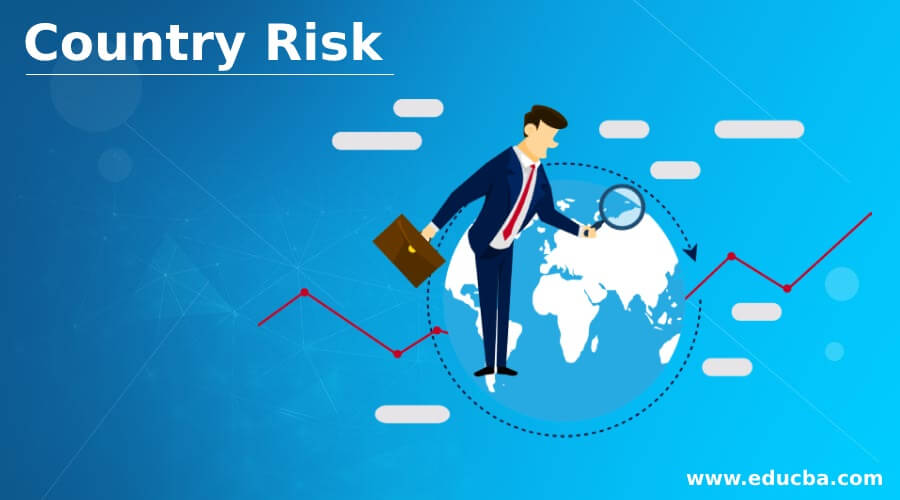Updated July 7, 2023
What is Country Risk?
“Country risk” refers to the uncertainty usually associated with an investment in a particular country. More importantly, it helps assess the extent of the financial losses the investors need to incur due to uncertainty. The uncertainty may be caused by several factors, such as economic, political, exchange rate, technological, etc.

Explanation
Typically, country risk qualitatively indicates the chances that a country’s government would default on its financial obligations or other similar commitments. Broadly, it shows how economic and political unrest in a country can adversely impact the valuation of the securities issued in that country. Investing in less developed nations where such risk can significantly reduce the expected return on investment (ROI) becomes critical.
Examples of Country Risk
Let us take the example of two countries – Canada and Nigeria. Let us assume that both countries have some upcoming projects for which they must raise funds by issuing bonds. The prospective investors need to assess which bond is safer and less likely to default. As such, the investors would look into various factors contributing to the country’s stability, such as political situation, economic health, inflation rate, tax system, etc.
After detailed analysis, the investors might realize Canada is a far safer investment option than Nigeria because of its political steadiness, economic well-being, technological advancement, etc. Hence, the investors might decide to invest in the projects in Canada as it has a much lower country risk than Nigeria.
Types
It can be divided into three major categories – sovereign, economic, and political risk.
- Sovereign Risk: It refers to the probability that a country’s central bank might bring in some drastic changes in rules that could impact the valuation of the investors’ holdings. It also indicates the probability of the government defaulting on its sovereign debt obligation.
- Economic Risk: It indicates a country’s economic health, which might include the probability of the country defaulting on its debt obligations, among other factors. There is some degree of overlap between economic risk and sovereign risk.
- Political Risk: It refers to the risk of losses arising from political instability within a country, such as frequent changes in government, civil war, trade disputes, etc. Such risks can be detrimental to the return on investment of the ongoing projects in that country.
Evaluating Country Risk
The evaluation of it can be a tricky business as it involves too many factors. Investors need to consider hundreds of different factors, from the existing tax regime to political turmoil, before arriving at the country risk of a nation. The evaluation process is discussed in more detail in assessing country risk.
Country Risk Ratings
The below table shows the country risk rating of the top 10 countries with the highest score in terms of overall risk with the highest weightage to the risk of money laundering. A higher score indicates that the risk of money laundering is lower, translating into more ease of business.
|
Sr. No. |
Country |
Score |
| 1 | Norway | 87.49 |
| 2 | Svalbard and Mayen | 87.49 |
| 3 | Sweden | 87.49 |
| 4 | Åland Islands | 86.75 |
| 5 | Finland | 86.75 |
| 6 | New Zealand | 85.81 |
| 7 | Tokelau | 85.81 |
| 8 | Denmark | 85.61 |
| 9 | Faroe islands | 85.61 |
| 10 | Greenland | 85.61 |
Source: Know Your Country
How to Assess Country Risk
It can be assessed either through quantitative or qualitative analysis.
- Quantitative method: This approach provides a definite number to the investors. Metrics like beta coefficients and debt-to-GDP ratio are classified as part of quantitative analysis. Many investors use the Morgan Stanley Capital Investment Index (MSCI)as the benchmark for assessing country risk.
- Qualitative method: This approach provides comparative measurements but not a definite risk number. Nevertheless, it captures all the latest developments that can help investors to a great extent.
Causes
Some of the most common causes of it are as follows:
- The position of the country in its economic growth life cycle. For instance, a country in its early growth is usually exposed to higher risk than a mature country.
- High levels of corruption lead to the circumvention of the rules and regulations that govern business and operations in the country.
- The lack of strict law enforcement can push away exiting investors and discourage prospective investors.
- High dependence on some particular products or services can result in severe economic shock in times of sudden decline in their demand.
Advantages
Some of the significant advantages are as follows:
- It helps the investors know what is expected from their investment in a particular country.
- Large corporates formulate strategies based on the risk rating of a particular country. They can treat each country according to its economic environment.
- It gives investors a tentative idea about a country’s political environment and financial health.
Disadvantages
Some of the major disadvantages are as follows:
- Country risk assessment depends on hundreds of factors, making it very complicated and increasing the chances of error. Even some of the most refined algorithms fail to capture all the factors accurately.
- The results of qualitative analysis are always debatable as they primarily depend on the availability and inclusion of evidence. So, there is a high chance that the results are not comprehensive.
Conclusion
Undoubtedly, increasing globalization and trade expansion between countries have increased the importance of country risk ratings. Investors use it to assess the riskiness of their investment and then accordingly avoid, diversify, or hedge their positions.
Recommended Articles
This is a guide to Country Risk. Here we also discuss the introduction, how to assess it, and its advantages and disadvantages. You may also have a look at the following articles to learn more –


